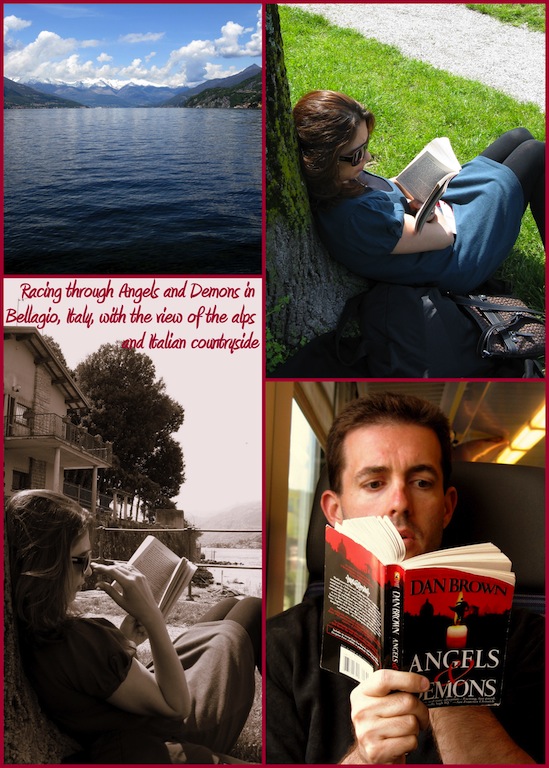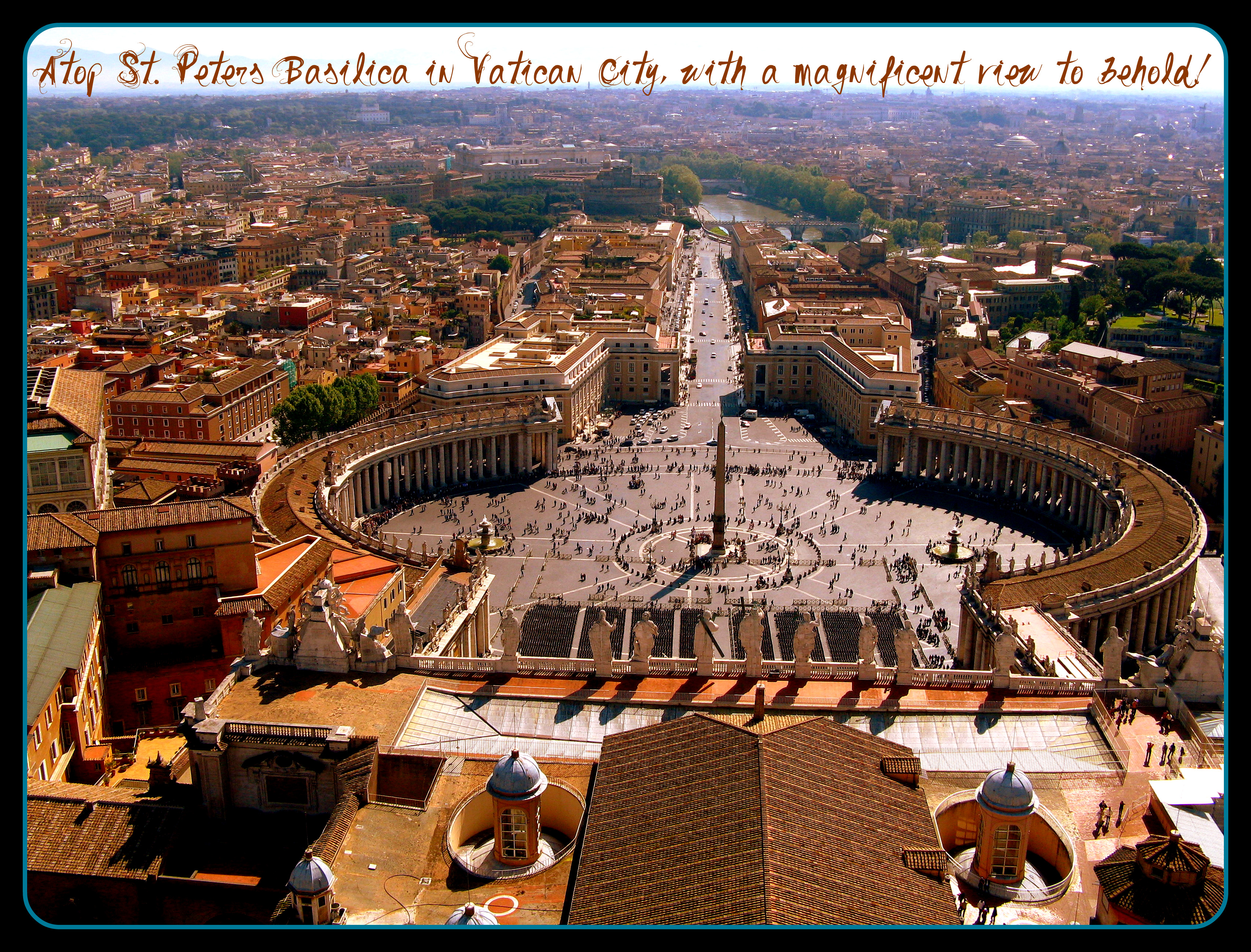 Reading “Angels and Demons“ in Italy added the intangible that makes reading a novel just right. Dan Brown‘s Robert Langdon, the famous Harvard symbologist, is out to solve a mystery about an ancient brotherhood called the Illuminati. The discovery of the existence of Illuminati, through a careful study of a genuine mark left on the body of a victim, sets the wheels of this fantastic novel in motion. The brotherhood is alive and well and they have in their possession the world’s most powerful agent called Antimatter, and their object is Vatican City.This is a story about Science’s retribution to the Catholic Church for years of ill treatment toward science and knowledge centuries ago. I found it to be an extremely delicious thriller – almost on par with the Da Vinci Code (in my words) in terms of suspense, knowledge on the subject matter, and plot – Dan Brown is a first-rate writer, selects the very best setting and story line, and has the right mix of fiction from his imagination and facts from his research.
Reading “Angels and Demons“ in Italy added the intangible that makes reading a novel just right. Dan Brown‘s Robert Langdon, the famous Harvard symbologist, is out to solve a mystery about an ancient brotherhood called the Illuminati. The discovery of the existence of Illuminati, through a careful study of a genuine mark left on the body of a victim, sets the wheels of this fantastic novel in motion. The brotherhood is alive and well and they have in their possession the world’s most powerful agent called Antimatter, and their object is Vatican City.This is a story about Science’s retribution to the Catholic Church for years of ill treatment toward science and knowledge centuries ago. I found it to be an extremely delicious thriller – almost on par with the Da Vinci Code (in my words) in terms of suspense, knowledge on the subject matter, and plot – Dan Brown is a first-rate writer, selects the very best setting and story line, and has the right mix of fiction from his imagination and facts from his research.
I have read novels where following the characters and relationships and actions was exhausting. The Shakespeare Secret is one such novel. It is a gifted author who can juggle so many different scenes, and seemingly diverging sub-plots, and still pull us along for the suspense, without resorting so much to our imagination than to our sense of adventure and curiosity. This was an extremely difficult thriller to put down. Here I was visiting the beautiful Italia for the first time, with sight seeing that I had planned for what seems weeks and months, and I had to exercise a great deal of discipline to leave the book behind! Finally, I managed to raise my husband’s curiosity to the point where he started reading it – and we were both racing through the novel as we traveled through Italy.
To my surprise, it only added to the experience since Brown’s major plots unfold in the world famous landmarks of Rome and Vatican City – I was standing in those landmarks, marveling at what the eye can see, and wondering of all that it cannot see – the knowledge, the history behind each tomb, each mark, each inscription on the wall or on the ground, each ancient stone and rock and monument, the memory of untold tragedies and celebrations these ancient buildings hold deep inside their structures. If only I were a butterfly on these walls in the days of Italian Renaissance or the Roman Age.
Robert Langdon is suddenly in serious company when the Illuminati brotherhood comes to surface -the director of CERN, Kohler, a man in a wheelchair who is more powerful than thousands on foot and Vittoria Vetra, the sexy physicist whose father is the murdered victim. Together, the Vettras have made a revolutionary discovery of Antimatter – so powerful that the tiniest amount, when come into contact with even just air, can create catastrophes proportional to large nuclear explosions. At the same time, as with all things, it can change humanity and advance science by leaps and bounds – it can fly our airplanes and heat our buildings and power our electronics in the speeds only dreamt of. It can just as easily destroy all humanity.
There are many parallels between the Da Vinci code and Angels and Demons – and yet, I find each book remarkably well written, thoroughly entertaining, terribly suspenseful and vastly researched by the author. Langdon is the same character, and as with Da Vinci Code, the female protagonist is the daughter whose father in one case and grandfather in other is murdered, in the name of the war of science and religion, leaving mysteries behind for Langdon and her to solve in the course of a deliciously stimulating maze of symbols and puzzles. Both books depict a world of symbols with significant meanings, a walk down history path to catch a glimpse of the world’s best thinkers, and a trail of twists and turns, murders and mysteries, suspense and action. A brilliantly written novel.
Whether the Illuminati really existed or not, Brown’s research and depth of information and articulation are impressive and leave you to wonder and decide. Robert Langdon is one of my favorite novel characters – his passion for the meanings behind symbols combined with his integrity to always do right by science and by humanity barely save him from the many tight corners he finds himself in. His devotion to preservation of science reaches its zenith when, having fallen out of a flying object into the cold water, and rescued by a miracle and recovering in a hospital bed, he is only truly distressed when he finds out the unintentionally borrowed Galileo paper in his pocket has dissolved in water, a piece of history lost forever at his expense.
History and science come alive in this book and Brown’s knowledge of religious rituals in Vatican city are beyond impressive. The climactic moments on this book revolve around the conclave, the assembly of the cardinals in the Sistine Chapel of Vatican City for the election of the new pope, and Brown provides a brilliantly meticulous account of this ritual with stunning twists in his story. The recent death of the pope. The genuinely portrayed Carmerlengo Carlo Ventresca who is in acting papal authority until the new pope is elected from one of 4 cardinals being considered, the Preferiti. The antimatter hidden somewhere below Vatican City. The unknown calls into Vatican depicting the upcoming sacrifice of each pope on the hour and the ultimate demolition of St. Peter’s Basilica and all its surrounding splendor, and the impossible situation of it all with nothing asked of the Carmerlengo, no option presented, only this the ultimate revenge by science for centuries of persecution of scientists by the church.
I applaud Dan Brown on the final twist. The least likely person being revealed as the villain sounds like an old trick used in movies and thrillers. The twist was not on the least likely characters but on an impossible that was made in minutes so plausible that you wondered how you did not think of it. On the contrary, what had built to be believable and central to the plot, is just the figment of someone’s imagination, brilliantly used for his own plans. Dr. Langon, it turns out, knew best on the account of Illuminati from the start.
As for science versus religion, whether pursuit of knowledge should come with a recipe of instructions so that we do ourselves more good than harm, those are the best questions asked again – not for first or last time – by Angels and Demons. The desire to know versus that of taking a leap of faith. The pursuit of understanding everything or questioning nothing but accepting the beauty and mystery of the world around us. Does it have to be mutually exclusive? Is there no harmony to be found between science and religion for mankind? Can not both serve us well and neither cause harm if we use our intelligence and common sense in the pursuit of truth?

 I am Farnoosh, the founder of Prolific Living. So glad you are here. My mission is to empower you to unblock your creative genius to live your dream life.
I am Farnoosh, the founder of Prolific Living. So glad you are here. My mission is to empower you to unblock your creative genius to live your dream life.